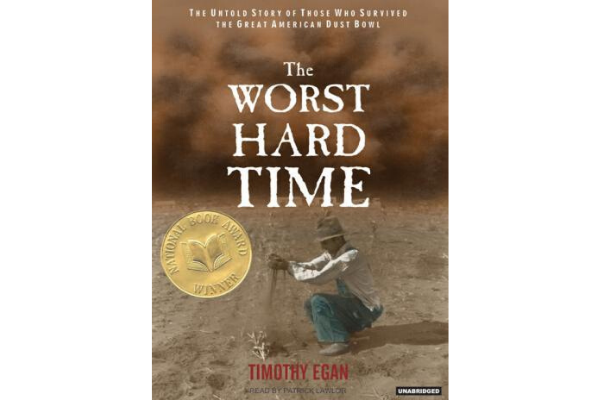The human misery and environmental calamity this nation’s midsection suffered during the “Dirty Thirties” is recounted in The Worst Hard Time: The Untold Story of Those Who Survived the Great American Dust Bowl (Hough- ton Miff lin; 312 pages plus notes, sources, and index).
The disastrous “Dirty Thirties” is also the subject of a moving photo exhibition at the Gilcrease Museum in Tulsa (“Dorothea Lange’s America,” through Jan. 5) that includes two iconic pictures from that period.
Prairie grassland that had lain undisturbed for thousands of years began to be plowed under, largely by immigrants and their descendants who were mistakenly encouraged to become farmers in the Great Plains, author Timothy Egan relates.
Nature turned hostile in the 1930s, bringing a chronic drought, hellish temperatures, and unceasing winds. With nothing to anchor the soil, dust blew “all over” the plains, but the “worst and most persistent storms” occurred in parts of five states: the Oklahoma and Texas Panhandles, southern Colorado, southwestern Kansas, and northeastern New Mexico.
Dust storms in which visibility was no farther than one-quarter mile numbered 14 in 1932; within two years it had quadrupled, to 56. The number peaked in 1937 at 134 “dusters.”
A “flock of whirlwinds” on May 19, 1934, started in the northern prairies and “merged into what looked to pilots like a solid block of airborne dirt,” the author writes. The duster was measured at 1,800 miles wide, a rectangle extending from the Great Plains to the Atlantic. In the NBC radio studios in New York, “air filters were changed hourly.” The storm moved out to sea, covering ships more than 200 miles from shore.
The worst was yet to come, though. On “Black Sunday,” April 14, 1935, a tsunami of soil stretched 500 miles north to south and 300 miles east to west. That storm carried twice as much dirt than was dug out of the Panama Canal; more than 300,000 tons of topsoil went airborne in a single afternoon.
In the Dust Bowl era, adults and children alike throughout the High Plains were afflicted with dust pneumonia, and a few actually suffocated, gagging on dust. Chickens choked to death and cattle went blind from the blowing dirt.
During one storm in the Oklahoma Panhandle in 1935, the wind was clocked at 40 mph or higher continuously for more than four consecutive days. The wind-whipped dirt generated static electricity, the author notes. “Men avoided shaking hands ... because static electricity could knock a person down,” and barbed wire fences emitted blue sparks.
The environmental catastrophe was aggravated by an economic Depression. One-fourth of the U.S. labor force was out of work, thousands of banks failed, and between 1930 and 1935 there were 750,000 bankruptcies or foreclosures on farms. In chronicling the lives of half a dozen families during the Dust Bowl, the author reports that some teachers in the Oklahoma Panhandle went nearly two years without pay.
Although some of the settlers remained defiant, the Great Plains experienced an exodus. Nearly a million farm families left their homesteads in 1930-35 because of the Depression, dusters, and drought, the author writes.
Remedial efforts started in 1937 with the planting of weeds, grass and millions of trees, and farmers began shaping furrows. However, the High Plains never fully recovered from the Dust Bowl. After more than 75 years, some of the lands is still sterile and drifting, the author points out.


